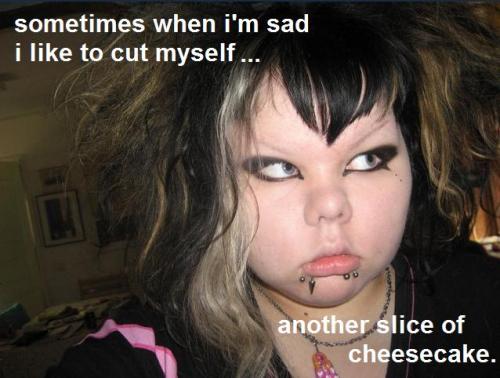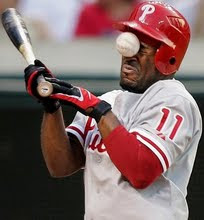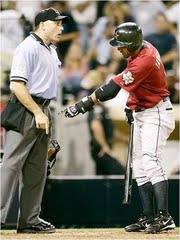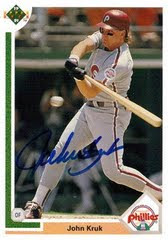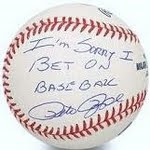This post is sparked by a debate that's happening in my current keeper fantasy baseball league. I am currently trying to trade away Carlos Quentin so I made a whole bunch of offers to my fellow league owners. An hour later I found out one of my trades was accepted- only to my dismay I had accidentally clicked on Carlos Pena instead of Carlos Quentin. I immediately asked the commissioner to rescind the trade. He did and then left a note on the league message board- that if I ever asked him to rescind a trade again, he would fail to do so. I got enraged (like I always do) but instead wrote a calm and rational post that the commish was being a dick (but I was nice and did not use profanity or obscenities). My response is the basis of this post.
Currently, there exists something called the Model Penal Code. It is a document written by some of the smartest lawyers, judges, professors, and experts in Criminal Law. These people come together to create a set of rules relating to crime in hope that they will be adopted by state and local governments to be the actual law. Although no one has ever adopted the full Model Penal Code, every state has adopted at least parts of it. I hope this post will be the Model Penal Code for your fantasy league and that you adopt it as "law"- or at least parts if it.
Although if your league currently has set rules about trading and such, that should be followed first and foremost over my ideals. If however no set guidelines were set, I strongly encourage this be your league's manifesto
TradesI am a firm believer that the only person who should have any say over how your team is run is you. If you make a trade that you think is fair but other people in your league think is unfair, tough for them. While one trade might hurt the league as a whole, that's just touch luck for the league because a trade does not occur for the benefit of the league, it occurs for the benefit of the owners involved in the league. That is why there should be no league vetoes.
There is an underlining assumption to this though- that both owners are acting in their team's best interest. When it is obvious that one owner is not acting in his own teams best interest (i.e. collusion, fire sale) then the trade should not be allowed. The standard should be "if no rational actor would ever make that trade, then the trade will not be allowed." However, if at least one owner, put in the position of the owners of the trade, would also make the trade- the trade should be allowed.
Imagine your league as the United Nations. It's a place where a bunch of people come together for a common goal. Like the United Nations, the sovereignty of the individual is more important than the whole. Each nation should be allowed to do whatever they want to- within reason or unless they consent to otherwise. However, what any individual nation does is up to them. They are a rational actor and they can make policies how they see fit. Same with a trade. The sovereignty of an individual owner needs to have the right to make rational decisions how he sees best and fit.
Intent is very important to show that a nation or owner is doing something that they see best and fit. Like a contract, a trade is a manifestation of the intent between two parties. For example, one party may need steals and the other one may need home runs. The owners then trade Justin Morneau for Julio Bourbon. This trade may seem extremely unfair (at least in April of 2010) but if both parties feel they are helping their team, then it does not matter if other people see that trade is unfair. The trade should be allowed.
It is only when the intent of two trading parties coincide that a trade should happen (likewise, when two parties both do not want to trade their players that does not occur either). When a trade offer is made, it is up to the opposing party to either accept, deny, or make a counter offer to the trade. We do not allow the trade before acceptance to go through when only one party (here the offering party) wants the trade but the other party (here the accepting party) chooses to deny or make a counter offer. It should not matter that one party express his intent about a trade he is involved in before or after the trade is accepted, if his intent clashes with his trading partners intent, then the trade will not be accepted.
Part of the problem currently with showing the intent of parties during trades is the medium in which we play fantasy sports. Very often have to make trades online. This limits the true intent of the parties. Sometimes, a party just wants to open up trade talks. Other times, the party wants to make that individual trade. It is at this moment where the intent is implicit and therefore should be held to looser acceptance standards. It is only when the intent becomes explicit that the acceptance standards be tighten. For example, Owner A makes an offer to Owner B just to open up trade talks and hopes Owner B will counter offer. Unfortunately, Owner B accepts the trade. The intent between the parties is different and implicit. When Owner A makes his intention explicit, that he did not want that trade to pass, that intent should be strictly followed.
The same logic that an owner has the right to have any player he is able to get onto his team applies to the opposite- that any owner has the right to not have any player on his team that he doesn't like. Which first of all means that there should not be an undroppable list. If an owner doesn't like particular player, he should have the right to drop him if he so chooses. This also means that if a trade has been accepted but it is not to any of the trading owner's liking- the trade should be rescinded. However, it is only when this intent to have have a particular player becomes explicit should the intent be honored.
The two current GOI leagues have a condition that if any owner of a trade wants his trade rescinded within 24 hours of the trade being accepted, the trade will be rescinded. I think the better rule is to replace a set time period like 24 hours with "a reasonable time" and it is up to the discretion of the commissioner to determine what a reasonable time is- although 24 hours seems like a good bench mark.
Speaking of the commissioner...
The CommissionerThe commissioner has two basic, explicit jobs- setting up the draft and affecting trades.
The Draft: His job should be to set a time (and possible place) that best suits everyone- or at least the vast majority of the league. The commissioner's job is to best suit the league for what draft time will work, not to best suit any individual player. The commissioner also sets up what stats will be used for the league. The best is the standard 5x5 (HR, SB, R, RBI, AVG, K, W, SV, WHIP, ERA) because although these stats are horrible to evaluate real players, they are much harder to predict than sabermetric stats and thus adds more fun to the league.
Every other aspect of a pre-draft (for example keeper rules) should be determined by the league as a whole with the commissioner being the final arbiter and mediator.
Affecting Trades: The main role of the commissioner here is to respect the intent of the parties. If a trade has been accepted by both parties, it is implicit that both parties want the trade to be processed and therefore it should. However, when one party of a trade, within a reasonable time, expresses his intent to not have the trade be processed, then it is the role of the commissioner to deny the trade. The commissioner will only use the parties intent and no one else's intent or motive when accepting or vetoing a trade.
Implicit in the commissioner's role is the social contract he signs with his league. The same concept of a social contract that Locke, Hobbes, and Rosseau talked about for sovereigns holds true for commissioners. A league without a leader is like Piggy on the island. Collusion, corruption, and overall mismanagement will plague the league. Which is why the league gives up some of their rights (i.e. veto power, setting up the league, etc.) to the commissioner. The commissioner has the power to do what he wants with the league (like the ability to mess with anyone's team and set rosters). However, the commissioner promises to establish order within the league and not do these things in exchange for the ability to perform his other administrative functions. The commissioner will do what's best for the league and the number one thing that is best for the league is honoring the sovereignty of every individual owner.
There are just certain things an individual league owner can not and should not do. That is where the power of the commissioner comes in. The league gives up their rights to do whatever they choose to do in exchange for league equality and the ease of not worrying about the trivial and overall functions of the league as a whole. The commissioner agrees to run the league and ensure the rights and intents of every individual owner is met in exchange to have the power (not the right) to do what he likes with the league.
However, implicit in this promise is to not overstep his boundaries- even though he has the power to do so. Because if the commissioner acts like a tyrant, then chaos will ensue again and would defeat the purpose of having one central leader. However, the commissioner can not also be weak and may need to use some of his power to retain order and balance in the league. The commissioner needs to have power but not use all of it in order to maintain a stable league.
InjuriesIf a player is traded and goes on the DL for an injury sustained BEFORE the trade was approved by the commissioner, then trade will be retroactively invalidated. If the injury is sustained AFTER the trade was approved by the commissioner, then the trade shall stand.
ComplainingThere will always be complaints in your league. But if owners and commissioners act pursuant to this Constitution or the set league rules, the complaining will be for naught.
If you must complain, don't be a whiny little bitch. All you end up doing is pissing everyone else off (A good life lesson, btw). If you must complain, take a deep breath, maybe don't start writing for about five minutes, and then explain your grievances. if you do so in a clear and well-thought out way, you are more likely to get your point across better.
Also, disparaging remarks should be never be tolerated no matter what forum they are being used in.
HAVE FUN!
 Justin Masterson was traded to the Cleveland Indians last year in the V-Mart trade. Many people thought the Red Sox were lucky that they didn't have to throw in Clay Buchholz in the deal. However, you may not have realized this but last year, in 16 games started, he had a FIP of 4.04 (4.05 xFIP) with a 8.28 K/9. Sure he also had a 4.52 ERA with a 4.18 BB/9 and a 1.45 WHIP, but Masterson's ability to strike out a ton of guys with a somewhat low FIP and xFIP along with his underlining numbers this year means that you should pick up Masterson now- because he's probably better than your last pitcher.
Justin Masterson was traded to the Cleveland Indians last year in the V-Mart trade. Many people thought the Red Sox were lucky that they didn't have to throw in Clay Buchholz in the deal. However, you may not have realized this but last year, in 16 games started, he had a FIP of 4.04 (4.05 xFIP) with a 8.28 K/9. Sure he also had a 4.52 ERA with a 4.18 BB/9 and a 1.45 WHIP, but Masterson's ability to strike out a ton of guys with a somewhat low FIP and xFIP along with his underlining numbers this year means that you should pick up Masterson now- because he's probably better than your last pitcher. The other major factor I like about Masterson is his 11.37 K/9. This is currently the second best among starters. Masterson has always been a strikeout guy in the minors and has shown the ability to strike out guys in the majors as well. While I don't reasonably expect Masterson to keep up this incredibly high K/9 rate, I do expect his to strike out a crap load of guys nonetheless.
The other major factor I like about Masterson is his 11.37 K/9. This is currently the second best among starters. Masterson has always been a strikeout guy in the minors and has shown the ability to strike out guys in the majors as well. While I don't reasonably expect Masterson to keep up this incredibly high K/9 rate, I do expect his to strike out a crap load of guys nonetheless. 






 TBO made an incredible run from starting out slow to finish in second place. He barely beat out the next team for that second place finish. Thank you everyone for playing and following the league!
TBO made an incredible run from starting out slow to finish in second place. He barely beat out the next team for that second place finish. Thank you everyone for playing and following the league!



























